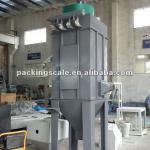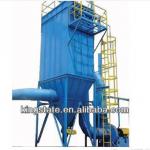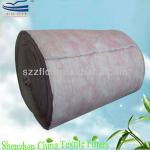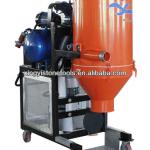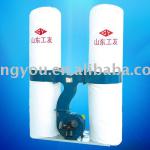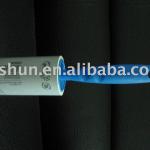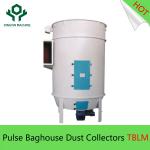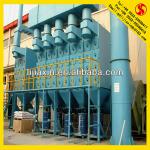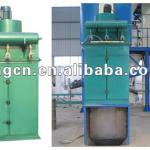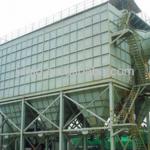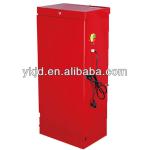Dust collector
| Condition:New | Type:Fabric Dust Collector | Place of Origin:Shanghai China (Mainland) | Brand Name:BPE |
| Model Number:DSC | Certification:ISO9001:2008 and CE | Warranty:1 year | After-sales Service Provided:Engineers available to service machinery overseas |
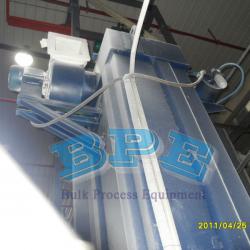
Five types of dust collectors used in bulk processing systems are:
- Inertial separators
- Fabric filters
- Wet scrubbers
- Electrostatic precipitators
- Unit collectors
Inertial Separators
Inertial separators separate dust from gas streams using a combination of forces, such as centrifugal, gravitational, and inertial. These forces move the dust to an area where the forces exerted by the gas stream are minimal. The separated dust is moved by gravity into a hopper, where it is temporarily stored.
Fabric filters
Commonly known as baghouses, fabric collectors use filtration to separate dust particles from dusty gases. They are one of the most efficient and cost effective types of dust collectors available and can achieve a collection efficiency of more than 99% for very fine particles.
Dust-laden gases enter the baghouse and pass through fabric bags that act as filters. The bags can be of woven or felted cotton, synthetic or glass-fiber material in either a tube or envelope shape.
Wet scrubbers
Dust collectors that use liquid are commonly known as wet scrubbers. In these systems, the scrubbing liquid (usually water) comes into contact with a gas stream containing dust particles. The greater the contact of the gas and liquid streams, the higher the dust removal efficiency.
All wet scrubbers have one of three basic operations:
- Gas-humidification
- Gas-liquid contact
- Gas-liquid separation
Electrostatic precipitators (ESP)
Electrostatic precipitators use electrostatic forces to separate dust particles from exhaust gases. Electrostatic precipitators operate on the same principle as home "Ionic" air purifiers. The airborne particles receive a negative charge as they pass through the ionized field between the electrodes. These charged particles are then attracted to a grounded or positively charged electrode and adhere to it.
The four main components of all electrostatic precipitators are:
- Power supply unit, to provide high-voltage DC power
- Ionizing section, to impart a charge to particles in the gas stream
- A means of removing the collected particles
- A housing to enclose the precipitator zone
Unit collectors
Unit collectors control contamination at its source. They are small and self-contained, consisting of a fan and some form of dust collector. They are suitable for isolated, portable, or frequently moved dust-producing operations, such as bins and silos or remote belt-conveyor transfer points.
There are two main types of unit collectors:
- Fabric collectors, with manual shaking or pulse-jet cleaning - normally used for fine dust
- Cyclone collectors - normally used for coarse dust
Types of Collectors
Five principal types of industrial dust collectors are:
- Inertial separators
- Fabric filters
- Wet scrubbers
- Electrostatic precipitators
- Unit collectors
Inertial separators
Inertial separators separate dust from gas streams using a combination of forces, such as centrifugal, gravitational, and inertial. These forces move the dust to an area where the forces exerted by the gas stream are minimal. The separated dust is moved by gravity into a hopper, where
it is temporarily stored.
The three primary types of inertial separators are:
- Settling chambers
- Baffle chambers
- Centrifugal collectors
Neither settling chambers nor baffle chambers are commonly used in the minerals processing industry. However, their principles of operation are often incorporated into the design of more efficient dust collectors.
Settling chamber
A settling chamber consists of a large box installed in the ductwork. The sudden expansion of size at the chamber reduces the speed of the dust-filled airstream and heavier particles settle out.
Settling chambers are simple in design and can be manufactured from almost any material. However, they are seldom used as primary dust collectors because of their large space requirements and low efficiency. A practical use is as precleaners for more efficient collectors.
Baffle chamber
Baffle chambers use a fixed baffle plate that causes the conveying gas stream to make a sudden change of direction. Large-diameter particles do not follow the gas stream but continue into a dead air space and settle. Baffle chambers are used as precleaners
Centrifugal collectors
Main article: Cyclonic separation
Centrifugal collectors use cyclonic action to separate dust particles from the gas stream. In a typical cyclone, the dust gas stream enters at an angle and is spun rapidly. The centrifugal force created by the circular flow throws the dust particles toward the wall of the cyclone. After striking the wall, these particles fall into a hopper located underneath.
The most common types of centrifugal, or inertial, collectors in use today are:
Single-cyclone separators
They create a dual vortex to separate coarse from fine dust. The main vortex spirals downward and carries most of the coarser dust particles. The inner vortex, created near the bottom of the cyclone, spirals upward and carries finer dust particles.
Multiple-cyclone separators
Also known as multiclones, consist of a number of small-diameter cyclones, operating in parallel and having a common gas inlet and outlet, as shown in the figure. Multi-clones operate on the same principle as cyclones--creating a main downward vortex and an ascending inner vortex.
Multiclones are more efficient than single cyclones because they are longer and smaller in diameter. The longer length provides longer residence time while the smaller diameter creates greater centrifugal force. These two factors result in better separation of dust particulates. The pressure drop of multiclone collectors is higher than that of single-cyclone separators.
Fabric filters
Commonly known as baghouses, fabric collectors use filtration to separate dust particulates from dusty gases. They are one of the most efficient and cost effective types of dust collectors available and can achieve a collection efficiency of more than 99% for very fine particulates.
Dust-laden gases enter the baghouse and pass through fabric bags that act as filters. The bags can be of woven or felted cotton, synthetic, or glass-fiber material in either a tube or envelope shape.
The high efficiency of these collectors is due to the dust cake formed on the surfaces of the bags. The fabric primarily provides a surface on which dust particulates collect through the following four mechanisms:
- Inertial collection - Dust particles strike the fibers placed perpendicular to the gas-flow direction instead of changing direction with the gas stream.
- Interception - Particles that do not cross the fluid streamlines come in contact with fibers because of the fiber size.
- Brownian movement - Submicrometre particles are diffused, increasing the probability of contact between the particles and collecting surfaces.
- Electrostatic forces - The presence of an electrostatic charge on the particles and the filter can increase dust capture.
A combination of these mechanisms results in formation of the dust cake on the filter, which eventually increases the resistance to gas flow. The filter must be cleaned periodically.
Types of baghouses
As classified by cleaning method, three common types of baghouses are:
Mechanical shaker
In mechanical-shaker baghouses, tubular filter bags are fastened onto a cell plate at the bottom of the baghouse and suspended from horizontal beams at the top. Dirty gas enters the bottom of the baghouse and passes through the filter, and the dust collects on the inside surface of the bags.
Cleaning a mechanical-shaker baghouse is accomplished by shaking the top horizontal bar from which the bags are suspended. Vibration produced by a motor-driven shaft and cam creates waves in the bags to shake off the dust cake.
Shaker baghouses range in size from small, handshaker devices to large, compartmentalized units. They can operate intermittently or continuously. Intermittent units can be used when processes operate on a batch basis-when a batch is completed, the baghouse can be cleaned. Continuous processes use compartmentalized baghouses; when one compartment is being cleaned, the airflow can be diverted to other compartments.
In shaker baghouses, there must be no positive pressure inside the bags during the shake cycle. Pressures as low as 0.02 in. wg can interfere with cleaning.
The air to cloth ratio for shaker baghouses is relatively low, hence the space requirements are quite high. However, because of the simplicity of design, they are popular in the minerals processing industry.
Reverse air
In reverse-air baghouses, the bags are fastened onto a cell plate at the bottom of the baghouse and suspended from an adjustable hanger frame at the top. Dirty gas flow normally enters the baghouse and passes through the bag from the inside, and the dust collects on the inside of the bags.
Reverse-air baghouses are compartmentalized to allow continuous operation. Before a cleaning cycle begins, filtration is stopped in the compartment to be cleaned. Bags are cleaned by injecting clean air into the dust collector in a reverse direction, which pressurizes the compartment. The pressure makes the bags collapse partially, causing the dust cake to crack and fall into the hopper below. At the end of the cleaning cycle, reverse airflow is discontinued, and the compartment is returned to the main stream.
The flow of the dirty gas helps maintain the shape of the bag. However, to prevent total collapse and fabric chafing during the cleaning cycle, rigid rings are sewn into the bags at intervals.
Space requirements for a reverse-air baghouse are comparable to those of a shaker baghouse; however, maintenance needs are somewhat greater.
Reverse jet
In reverse-pulse-jet baghouses, individual bags are supported by a metal cage, which is fastened onto a cell plate at the top of the baghouse. Dirty gas enters from the bottom of the baghouse and flows from outside to inside the bags. The metal cage prevents collapse of the bag.
Bags are cleaned by a short burst of compressed air injected through a common manifold over a row of bags. The compressed air is accelerated by a venturi nozzle mounted at the reverse-jet baghouse top of the bag. Since the duration of the compressed-air burst is short (0.1s), it acts as a rapidly moving air bubble, traveling through the entire length of the bag and causing the bag surfaces to flex. This flexing of the bags breaks the dust cake, and the dislodged dust falls into a storage hopper below.
Reverse-pulse-jet dust collectors can be operated continuously and cleaned without interruption of flow because the burst of compressed air is very small compared with the total volume of dusty air through the collector. Because of this continuous-cleaning feature, reverse-jet dust collectors are usually not compartmentalized.
The short cleaning cycle of reverse-jet collectors reduces recirculation and redeposit of dust. These collectors provide more complete cleaning and reconditioning of bags than shaker or reverse-air cleaning methods. Also, the continuous-cleaning feature allows them to operate at higher air-to-cloth ratios, so the space requirements are lower.
This cleaning system works with the help of digital sequential timer attached to the fabric filter. this timer indicates the solenoid valve to inject the air to the blow pipe.
Fabric filters generally have the following parts:
1. Clean plenum
2. Dusty pleanum
3. Bag, cage, ventury assembly
4. Tubeplate
5. RAV/SCREW
6. Compressed air header
7. Blow pipe
8. Housing and hopper
Cartridge collectors
Cartridge collectors are another commonly used type of dust collector. Unlike baghouse collectors, in which the filtering media is woven or felt bags, this type of collector employs perforated metal cartridges that contain a pleated, nonwoven filtering media. Due to its pleated design, the total filtering surface area is greater than in a conventional bag of the same diameter, resulting in reduced air to media ratio, pressure drop, and overall collector size.
Cartridge collectors are available in single use or continuous duty designs. In single-use collectors, the dirty cartridges are changed while the collector is off. In the continuous duty design, the cartridges are cleaned by the conventional pulse-jet cleaning system.
Almost always includes a steel enclosure containing porous filter media that separate fine dust particles from a flowing stream of dirty air. The most common filter media used in collectors are filter bags and cartridges. Dust particles build up on the outside of the media and form a coating called "dust cake." It is this layer that does the actual job of filtering fine particles. As the cake builds up, the pressure drop across the filter bag rises.
Wet scrubbers
Dust collectors that use liquid are commonly known as wet scrubbers. In these systems, the scrubbing liquid (usually water) comes into contact with a gas stream containing dust particles. The greater the contact of the gas and liquid streams, the higher the dust removal efficiency.
There are a large variety of wet scrubbers; however, all have one of three basic operations:
- Gas-humidification - The gas-humidification process conditions fine particles to increase their size so they can be collected more easily.
- Gas-liquid separation - Regardless of the contact mechanism used, as much liquid and dust as possible must be removed. Once contact is made, dust particulates and water droplets combine to form agglomerates. As the agglomerates grow larger, they settle into a collector.
- Gas-liquid contact - This is one of the most important factors affecting collection efficiency. The particle and droplet come into contact by four primary mechanisms:
- Inertial impaction - When water droplets placed in the path of a dust-laden gas stream, the stream separates and flows around them. Due to inertia, the larger dust particles will continue on in a straight path, hit the droplets, and become encapsulated.
- Interception - Finer particles moving within a gas stream do not hit droplets directly but brush against them and adhere to them.
- Diffusion - When liquid droplets are scattered among dust particles, the particles are deposited on the droplet surfaces by Brownian movement, or diffusion. This is the principal mechanism in the collection of submicrometre dust particles.
- Condensation nucleation - If a gas passing through a scrubber is cooled below the dewpoint, condensation of moisture occurs on the dust particles. This increase in particle size makes collection easier.
The "cleaned" gases are normally passed through a mist eliminator (demister pads) to remove water droplets from the gas stream. The dirty water from the scrubber system is either cleaned and discharged or recycled to the scrubber. Dust is removed from the scrubber in a clarification unit or a drag chain tank. In both systems solid material settles on the bottom of the tank. A drag chain system removes the sludge and deposits in into a dumpster or stockpile.

| Packaging Detail:in bulk |
| Delivery Detail:2months after deposit |



